Answered step by step
Verified Expert Solution
Question
1 Approved Answer
Q1. what is the problem? write this in a form of a formal problem statement, including the target. current state and desired state. 2 UV6787
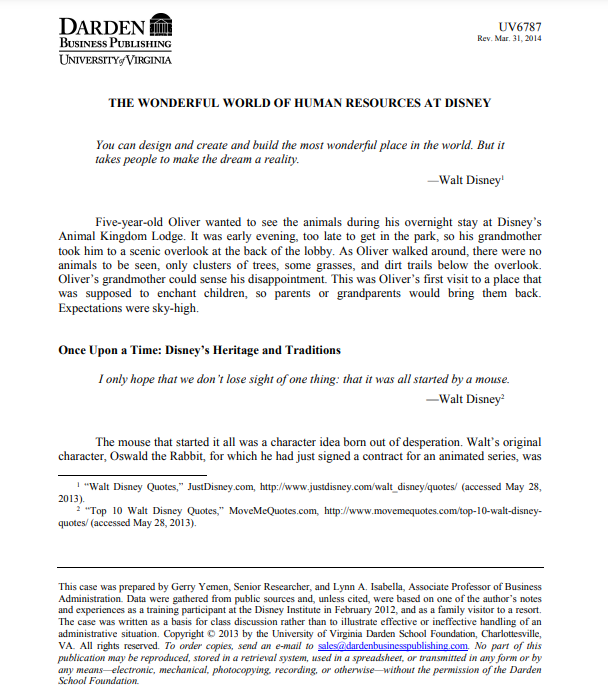

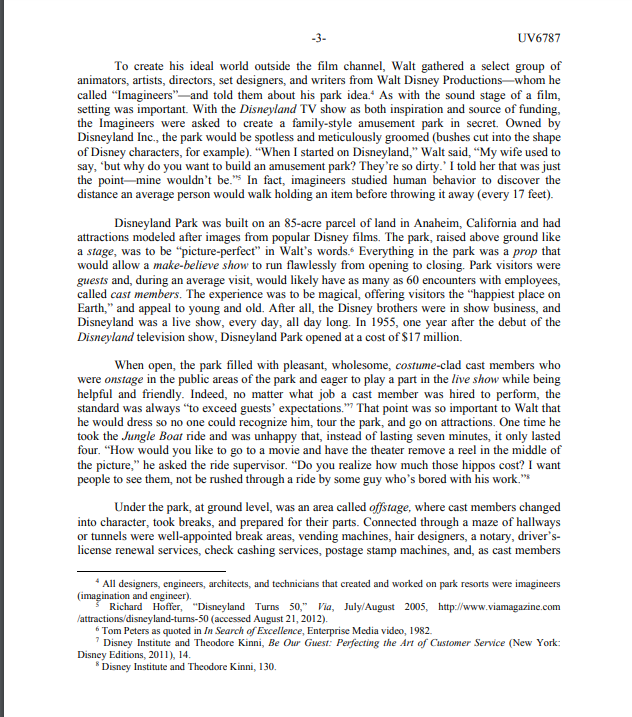
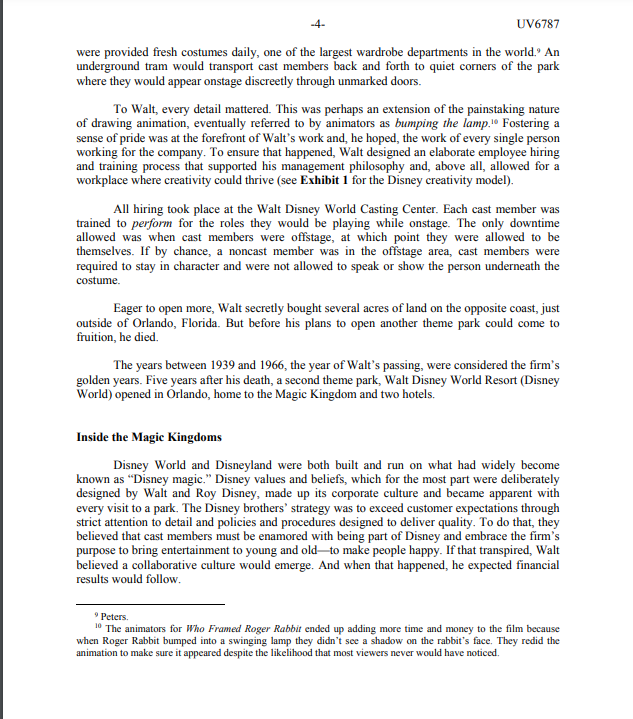
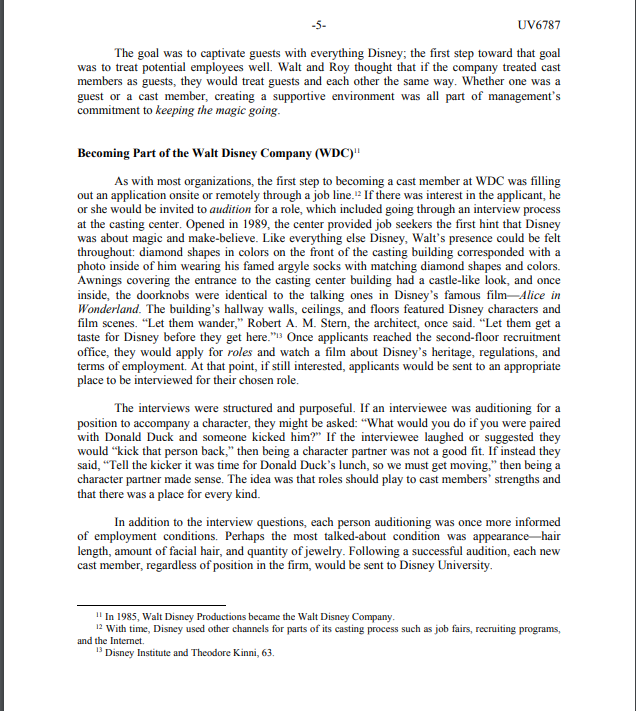
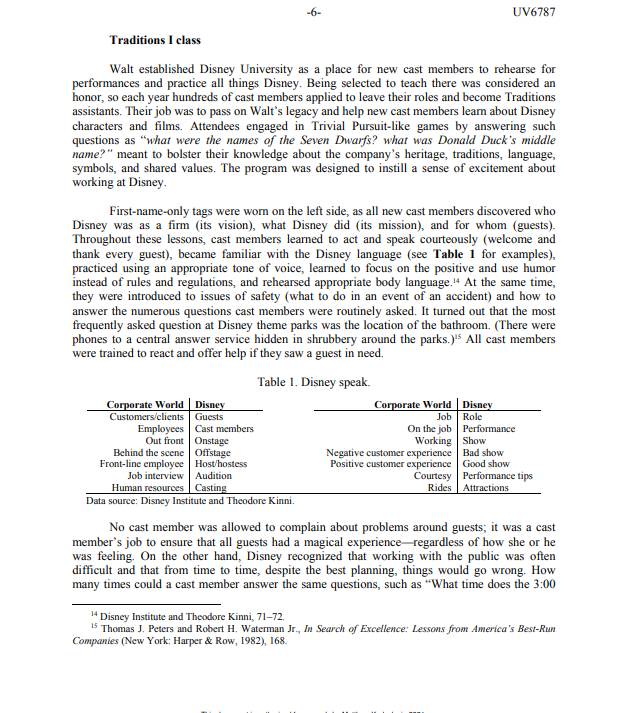
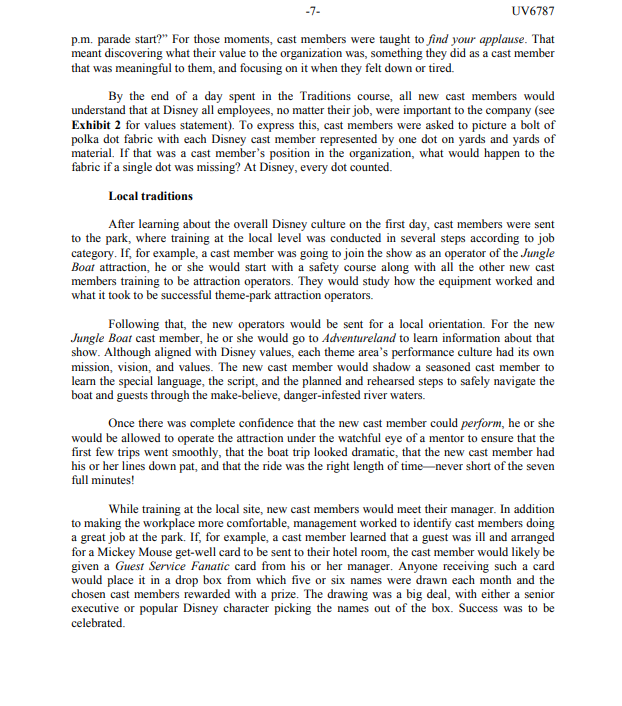
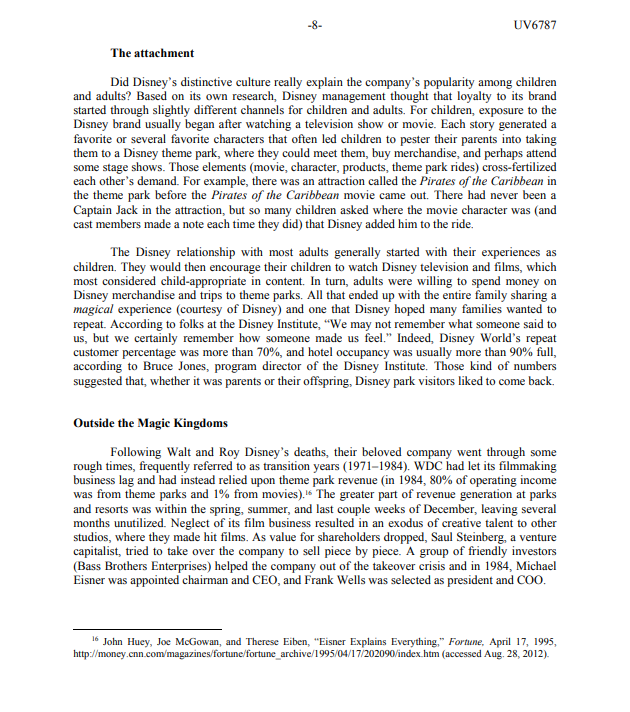
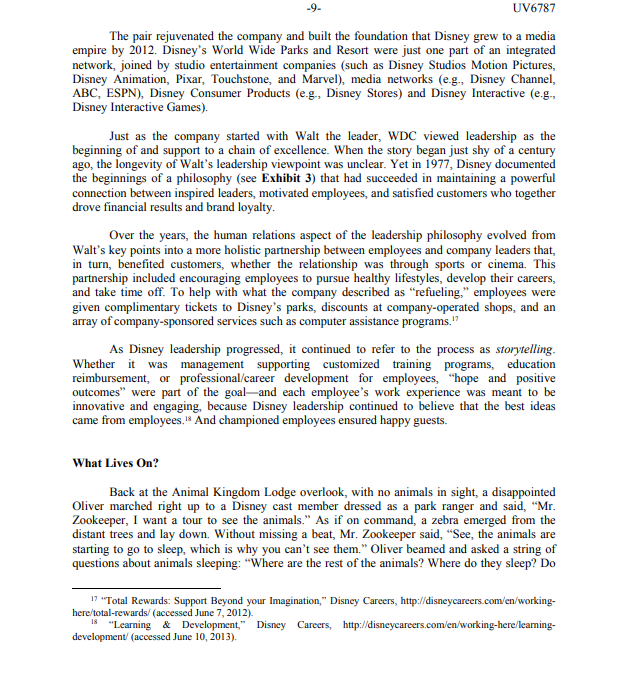
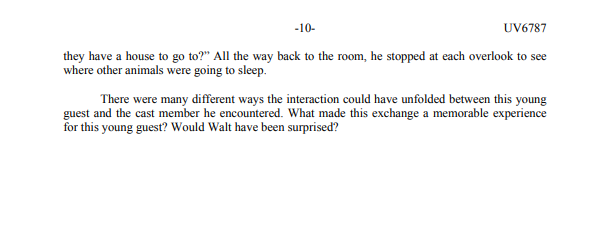
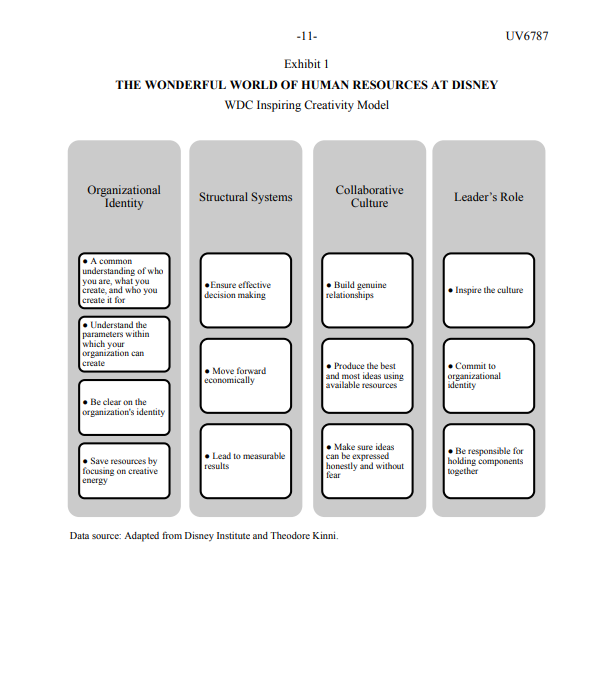

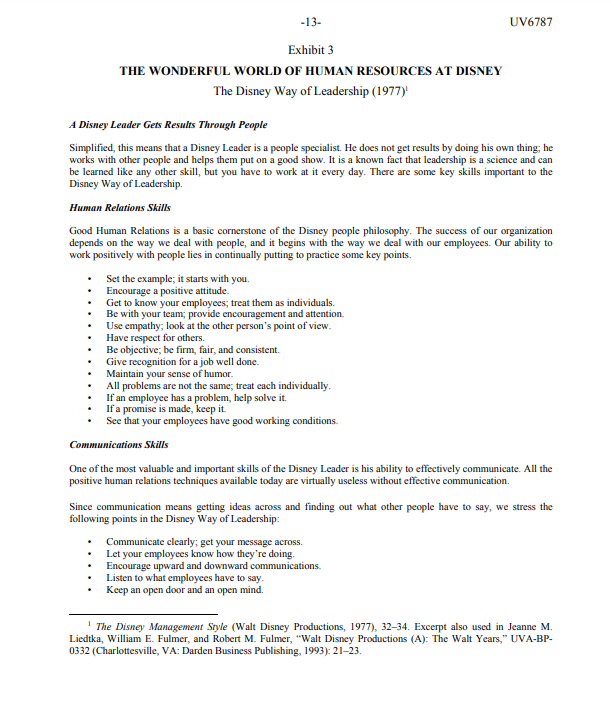
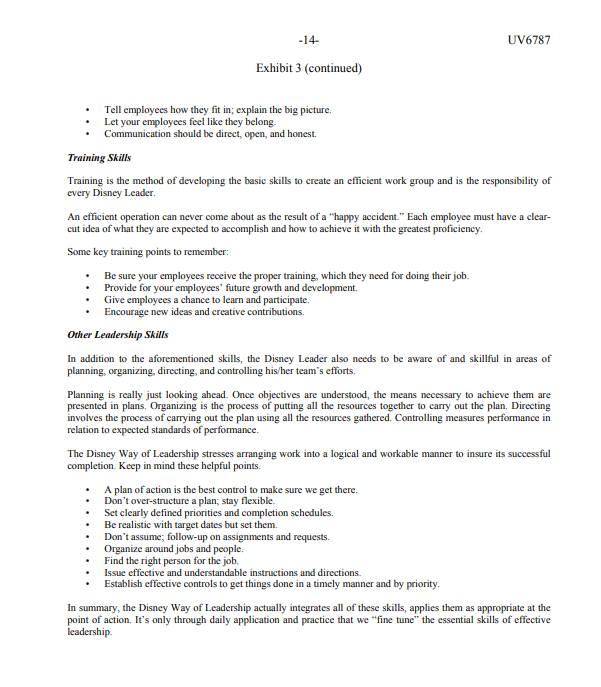
Q1. what is the problem? write this in a form of a formal problem statement, including the target. current state and desired state.
2 UV6787 stolen by the New York distributor, who then hired all of Walt's animators. On the train ride back home, Walt got the idea for a mouse. "A mouse had always appealed to me," he said. "While working in Kansas City, I caught several in wastebaskets around the studio. I kept them in a cage on my desk and enjoyed watching their antics. m3 The original name was to be Mortimer Mouse, but Walt's wife, Lilly, convinced him that the name Mortimer seemed too formal. Mickey Mouse, the character that people loved and the icon of an empire-to-be, was born. The animated film company that Walt founded in 1923 with his brother Roy (who put up most of the money) got busy. Walt introduced the use of sound, then in its motion-picture infancy, in the first talking animated film, Steamboat Willie. The film debuted in New York City in 1928, and was a hit. Disney Brothers Studios was launched; a year later it was renamed "Walt Disney Productions." To go along with the red-shorted, yellow-shoed mouse, Walt dreamed up some friends: Pluto in 1930, Goofy in 1932, and Donald Duck in 1934. The brothers licensed these Disney characters and began selling merchandise such as shirts, watches, and writing tablets with their images. By 1937, Mickey's image, on one distributed product or another, had found its way to 38 countries; to handle the volume, distribution offices for merchandise and films opened in Paris and London. Mickey Mouse clubs started cropping up worldwide. Disney products had a global appeal and reach. Walt Disney Productions struggled financially for a while, but with the help of Bank of America and some of their own money, the Disney brothers created a film in color called Snow White and the Seven Dwarfs. Premiering in 1937 and opening nationwide in 1938, it was a financial and artistic success, making millions of dollars. After that, Walt's imagination and Roy's business acumen were an unstoppable combination, and by 1940, the firm had issued its first stock. In 1954, they used another medium to share Walt's imagination with the world: the brothers created a television show called Disneyland (later called The Wonderful World of Disney). Now Disney movie fans turned on their television sets each Sunday evening and watched a variety of Disney characters and stories. From Film to Theme Park As it turned out, filmmaking and television shows were not the only projects on the drawing board. The idea of expanding into theme parks came from the same guy who drew the famous mouse-Walt. Although Roy was against the concept at first, creating a theme park fit well with both Walt's urge to escape the real world and dream and his goal to create happiness for those who visited. 3 James R. Stewart, Disney War (New York: Simon \& Schuster, 2005), 23. 3 UV6787 To create his ideal world outside the film channel, Walt gathered a select group of animators, artists, directors, set designers, and writers from Walt Disney Productions - whom he called "Imagineers" - and told them about his park idea. 4 As with the sound stage of a film, setting was important. With the Disneyland TV show as both inspiration and source of funding, the Imagineers were asked to create a family-style amusement park in secret. Owned by Disneyland Inc., the park would be spotless and meticulously groomed (bushes cut into the shape of Disney characters, for example). "When I started on Disneyland," Walt said, "My wife used to say, 'but why do you want to build an amusement park? They're so dirty.' I told her that was just the point - mine wouldn't be." In fact, imagineers studied human behavior to discover the distance an average person would walk holding an item before throwing it away (every 17 feet). Disneyland Park was built on an 85 -acre parcel of land in Anaheim, California and had attractions modeled after images from popular Disney films. The park, raised above ground like a stage, was to be "picture-perfect" in Walt's words. 6 Everything in the park was a prop that would allow a make-believe show to run flawlessly from opening to closing. Park visitors were guests and, during an average visit, would likely have as many as 60 encounters with employees, called cast members. The experience was to be magical, offering visitors the "happiest place on Earth," and appeal to young and old. After all, the Disney brothers were in show business, and Disneyland was a live show, every day, all day long. In 1955 , one year after the debut of the Disneyland television show, Disneyland Park opened at a cost of $17 million. When open, the park filled with pleasant, wholesome, costume-clad cast members who were onstage in the public areas of the park and eager to play a part in the live show while being helpful and friendly. Indeed, no matter what job a cast member was hired to perform, the standard was always "to exceed guests' expectations." m That point was so important to Walt that he would dress so no one could recognize him, tour the park, and go on attractions. One time he took the Jungle Boat ride and was unhappy that, instead of lasting seven minutes, it only lasted four. "How would you like to go to a movie and have the theater remove a reel in the middle of the picture," he asked the ride supervisor. "Do you realize how much those hippos cost? I want people to see them, not be rushed through a ride by some guy who's bored with his work." Under the park, at ground level, was an area called offstage, where cast members changed into character, took breaks, and prepared for their parts. Connected through a maze of hallways or tunnels were well-appointed break areas, vending machines, hair designers, a notary, driver'slicense renewal services, check cashing services, postage stamp machines, and, as cast members 4 All designers, engineers, architects, and technicians that created and worked on park resorts were imagineers (imagination and engincer). Richard Hoffer, "Disneyland Turns 50," Via, July/August 2005, http:J/www.viamagazine.com /attractions/disneyland-tums-50 (accessed August 21, 2012). 6 Tom Peters as quoted in In Search of Excellence, Enterprise Media video, 1982 7 Disney Institute and Theodore Kinni, Be Our Guest: Perfecting the Art of Customer Service (New York: Disney Editions, 2011), 14. 8 Disney Institute and Theodore Kinni, 130. -4 - UV6787 were provided fresh costumes daily, one of the largest wardrobe departments in the world. 9 An underground tram would transport cast members back and forth to quiet corners of the park where they would appear onstage discreetly through unmarked doors. To Walt, every detail mattered. This was perhaps an extension of the painstaking nature of drawing animation, eventually referred to by animators as bumping the lamp. 10 Fostering a sense of pride was at the forefront of Walt's work and, he hoped, the work of every single person working for the company. To ensure that happened, Walt designed an elaborate employee hiring and training process that supported his management philosophy and, above all, allowed for a workplace where creativity could thrive (see Exhibit 1 for the Disney creativity model). All hiring took place at the Walt Disney World Casting Center. Each cast member was trained to perform for the roles they would be playing while onstage. The only downtime allowed was when cast members were offstage, at which point they were allowed to be themselves. If by chance, a noncast member was in the offstage area, cast members were required to stay in character and were not allowed to speak or show the person underneath the costume. Eager to open more, Walt secretly bought several acres of land on the opposite coast, just outside of Orlando, Florida. But before his plans to open another theme park could come to fruition, he died. The years between 1939 and 1966, the year of Walt's passing, were considered the firm's golden years. Five years after his death, a second theme park, Walt Disney World Resort (Disney World) opened in Orlando, home to the Magic Kingdom and two hotels. Inside the Magic Kingdoms Disney World and Disneyland were both built and run on what had widely become known as "Disney magic." Disney values and beliefs, which for the most part were deliberately designed by Walt and Roy Disney, made up its corporate culture and became apparent with every visit to a park. The Disney brothers' strategy was to exceed customer expectations through strict attention to detail and policies and procedures designed to deliver quality. To do that, they believed that cast members must be enamored with being part of Disney and embrace the firm's purpose to bring entertainment to young and old - to make people happy. If that transpired, Walt believed a collaborative culture would emerge. And when that happened, he expected financial results would follow. 9 Peters. 10 The animators for Who Framed Roger Rabbit ended up adding more time and money to the film because when Roger Rabbit bumped into a swinging lamp they didn't see a shadow on the rabbit's face. They redid the animation to make sure it appeared despite the likelihood that most viewers never would have noticed. The goal was to captivate guests with everything Disney; the first step toward that goal was to treat potential employees well. Walt and Roy thought that if the company treated cast members as guests, they would treat guests and each other the same way. Whether one was a guest or a cast member, creating a supportive environment was all part of management's commitment to keeping the magic going. Becoming Part of the Walt Disney Company (WDC) As with most organizations, the first step to becoming a cast member at WDC was filling out an application onsite or remotely through a job line. 12 If there was interest in the applicant, he or she would be invited to audition for a role, which included going through an interview process at the casting center. Opened in 1989, the center provided job seekers the first hint that Disney was about magic and make-believe. Like everything else Disney, Walt's presence could be felt throughout: diamond shapes in colors on the front of the casting building corresponded with a photo inside of him wearing his famed argyle socks with matching diamond shapes and colors. Awnings covering the entrance to the casting center building had a castle-like look, and once inside, the doorknobs were identical to the talking ones in Disney's famous film-Alice in Wonderland. The building's hallway walls, ceilings, and floors featured Disney characters and film scenes. "Let them wander," Robert A. M. Stern, the architect, once said. "Let them get a taste for Disney before they get here."13 Once applicants reached the second-floor recruitment office, they would apply for roles and watch a film about Disney's heritage, regulations, and terms of employment. At that point, if still interested, applicants would be sent to an appropriate place to be interviewed for their chosen role. The interviews were structured and purposeful. If an interviewee was auditioning for a position to accompany a character, they might be asked: "What would you do if you were paired with Donald Duck and someone kicked him?" If the interviewee laughed or suggested they would "kick that person back," then being a character partner was not a good fit. If instead they said, "Tell the kicker it was time for Donald Duck's lunch, so we must get moving," then being a character partner made sense. The idea was that roles should play to cast members' strengths and that there was a place for every kind. In addition to the interview questions, each person auditioning was once more informed of employment conditions. Perhaps the most talked-about condition was appearance-hair length, amount of facial hair, and quantity of jewelry. Following a successful audition, each new cast member, regardless of position in the firm, would be sent to Disney University. II In 1985, Walt Disney Productions became the Walt Disncy Company. 12 With time, Disney used other channels for parts of its casting process such as job fairs, recruiting programs, and the Internet. 13 Disney Institute and Theodore Kinni, 63. Traditions I class Walt established Disney University as a place for new cast members to rehearse for performances and practice all things Disney. Being selected to teach there was considered an honor, so each year hundreds of cast members applied to leave their roles and become Traditions assistants. Their job was to pass on Walt's legacy and help new cast members learn about Disney characters and films. Attendees engaged in Trivial Pursuit-like games by answering such questions as "what were the names of the Seven Dwarfs? what was Donald Duck's middle name?" meant to bolster their knowledge about the company's heritage, traditions, language, symbols, and shared values. The program was designed to instill a sense of excitement about working at Disney. First-name-only tags were worn on the left side, as all new cast members discovered who Disney was as a firm (its vision), what Disney did (its mission), and for whom (guests). Throughout these lessons, cast members learned to act and speak courteously (welcome and thank every guest), became familiar with the Disney language (see Table 1 for examples), practiced using an appropriate tone of voice, learned to focus on the positive and use humor instead of rules and regulations, and rehearsed appropriate body language. 14 At the same time, they were introduced to issues of safety (what to do in an event of an accident) and how to answer the numerous questions cast members were routinely asked. It turned out that the most frequently asked question at Disney theme parks was the location of the bathroom. (There were phones to a central answer service hidden in shrubbery around the parks. )15 All cast members were trained to react and offer help if they saw a guest in need. Table 1. Disney speak. No cast member was allowed to complain about problems around guests; it was a cast member's job to ensure that all guests had a magical experience-regardless of how she or he was feeling. On the other hand, Disney recognized that working with the public was often difficult and that from time to time, despite the best planning, things would go wrong. How many times could a cast member answer the same questions, such as "What time does the 3:00 14 Disney Institute and Theodore Kinni, 7172. 15 Thomas J. Peters and Robert H. Waterman Jr., In Search of Excellence: Lessons from America's Best-Run Companies (New York: Harper \& Row, 1982), 168. 7 UV6787 p.m. parade start?" For those moments, cast members were taught to find your applause. That meant discovering what their value to the organization was, something they did as a cast member that was meaningful to them, and focusing on it when they felt down or tired. By the end of a day spent in the Traditions course, all new cast members would understand that at Disney all employees, no matter their job, were important to the company (see Exhibit 2 for values statement). To express this, cast members were asked to picture a bolt of polka dot fabric with each Disney cast member represented by one dot on yards and yards of material. If that was a cast member's position in the organization, what would happen to the fabric if a single dot was missing? At Disney, every dot counted. Local traditions After learning about the overall Disney culture on the first day, cast members were sent to the park, where training at the local level was conducted in several steps according to job category. If, for example, a cast member was going to join the show as an operator of the Jungle Boat attraction, he or she would start with a safety course along with all the other new cast members training to be attraction operators. They would study how the equipment worked and what it took to be successful theme-park attraction operators. Following that, the new operators would be sent for a local orientation. For the new Jungle Boat cast member, he or she would go to Adventureland to learn information about that show. Although aligned with Disney values, each theme area's performance culture had its own mission, vision, and values. The new cast member would shadow a seasoned cast member to learn the special language, the script, and the planned and rehearsed steps to safely navigate the boat and guests through the make-believe, danger-infested river waters. Once there was complete confidence that the new cast member could perform, he or she would be allowed to operate the attraction under the watchful eye of a mentor to ensure that the first few trips went smoothly, that the boat trip looked dramatic, that the new cast member had his or her lines down pat, and that the ride was the right length of time-never short of the seven full minutes! While training at the local site, new cast members would meet their manager. In addition to making the workplace more comfortable, management worked to identify cast members doing a great job at the park. If, for example, a cast member learned that a guest was ill and arranged for a Mickey Mouse get-well card to be sent to their hotel room, the cast member would likely be given a Guest Service Fanatic card from his or her manager. Anyone receiving such a card would place it in a drop box from which five or six names were drawn each month and the chosen cast members rewarded with a prize. The drawing was a big deal, with either a senior executive or popular Disney character picking the names out of the box. Success was to be celebrated. 8 UV6787 The attachment Did Disney's distinctive culture really explain the company's popularity among children and adults? Based on its own research, Disney management thought that loyalty to its brand started through slightly different channels for children and adults. For children, exposure to the Disney brand usually began after watching a television show or movie. Each story generated a favorite or several favorite characters that often led children to pester their parents into taking them to a Disney theme park, where they could meet them, buy merchandise, and perhaps attend some stage shows. Those elements (movie, character, products, theme park rides) cross-fertilized each other's demand. For example, there was an attraction called the Pirates of the Caribbean in the theme park before the Pirates of the Caribbean movie came out. There had never been a Captain Jack in the attraction, but so many children asked where the movie character was (and cast members made a note each time they did) that Disney added him to the ride. The Disney relationship with most adults generally started with their experiences as children. They would then encourage their children to watch Disney television and films, which most considered child-appropriate in content. In turn, adults were willing to spend money on Disney merchandise and trips to theme parks. All that ended up with the entire family sharing a magical experience (courtesy of Disney) and one that Disney hoped many families wanted to repeat. According to folks at the Disney Institute, "We may not remember what someone said to us, but we certainly remember how someone made us feel." Indeed, Disney World's repeat customer percentage was more than 70%, and hotel occupancy was usually more than 90% full, according to Bruce Jones, program director of the Disney Institute. Those kind of numbers suggested that, whether it was parents or their offspring, Disney park visitors liked to come back. Outside the Magic Kingdoms Following Walt and Roy Disney's deaths, their beloved company went through some rough times, frequently referred to as transition years (1971-1984). WDC had let its filmmaking business lag and had instead relied upon theme park revenue (in 1984, 80% of operating income was from theme parks and 1% from movies). 16 The greater part of revenue generation at parks and resorts was within the spring, summer, and last couple weeks of December, leaving several months unutilized. Neglect of its film business resulted in an exodus of creative talent to other studios, where they made hit films. As value for shareholders dropped, Saul Steinberg, a venture capitalist, tried to take over the company to sell piece by piece. A group of friendly investors (Bass Brothers Enterprises) helped the company out of the takeover crisis and in 1984, Michael Eisner was appointed chairman and CEO, and Frank Wells was selected as president and COO. 16 John Huey, Joe MoGowan, and Therese Eiben, "Eisner Explains Everything," Fortune, April 17, 1995, http// money.cnn_com/magazines/fortune/fortune_archive/1995/04/17/202090/index.htm (accessed Aug. 28, 2012). 9 UV6787 The pair rejuvenated the company and built the foundation that Disney grew to a media empire by 2012. Disney's World Wide Parks and Resort were just one part of an integrated network, joined by studio entertainment companies (such as Disney Studios Motion Pictures, Disney Animation, Pixar, Touchstone, and Marvel), media networks (e.g., Disney Channel, ABC, ESPN), Disney Consumer Products (e.g., Disney Stores) and Disney Interactive (e.g., Disney Interactive Games). Just as the company started with Walt the leader, WDC viewed leadership as the beginning of and support to a chain of excellence. When the story began just shy of a century ago, the longevity of Walt's leadership viewpoint was unclear. Yet in 1977, Disney documented the beginnings of a philosophy (see Exhibit 3 ) that had succeeded in maintaining a powerful connection between inspired leaders, motivated employees, and satisfied customers who together drove financial results and brand loyalty. Over the years, the human relations aspect of the leadership philosophy evolved from Walt's key points into a more holistic partnership between employees and company leaders that, in turn, benefited customers, whether the relationship was through sports or cinema. This partnership included encouraging employees to pursue healthy lifestyles, develop their careers, and take time off. To help with what the company described as "refueling," employees were given complimentary tickets to Disney's parks, discounts at company-operated shops, and an array of company-sponsored services such as computer assistance programs. 17 As Disney leadership progressed, it continued to refer to the process as storytelling. Whether it was management supporting customized training programs, education reimbursement, or professional/career development for employees, "hope and positive outcomes" were part of the goal-and each employee's work experience was meant to be innovative and engaging, because Disney leadership continued to believe that the best ideas came from employees. 18 And championed employees ensured happy guests. What Lives On? Back at the Animal Kingdom Lodge overlook, with no animals in sight, a disappointed Oliver marched right up to a Disney cast member dressed as a park ranger and said, "Mr. Zookeeper, I want a tour to see the animals." As if on command, a zebra emerged from the distant trees and lay down. Without missing a beat, Mr. Zookeeper said, "See, the animals are starting to go to sleep, which is why you can't see them." Oliver beamed and asked a string of questions about animals sleeping: "Where are the rest of the animals? Where do they sleep? Do 17 "Total Rewards: Support Beyond your Imagination," Disney Careers, http://disneycareers.com/en/workinghere/total-rewards/ (accessed June 7, 2012). 18 "Learning \& Development," Disney Careers, http://disneycareers.com/en/working-here/learningdevelopment' (accessed June 10, 2013). they have a house to go to?" All the way back to the room, he stopped at each overlook to see where other animals were going to sleep. There were many different ways the interaction could have unfolded between this young guest and the cast member he encountered. What made this exchange a memorable experience for this young guest? Would Walt have been surprised? Data source: Adapted from Disney Institute and Theodore Kinni. Exhibit 2 THE WONDERFUL WORLD OF HUMAN RESOURCES AT DISNEY The Walt Disney Company Human Resources 1 We aspire to inspire together. Diversity Having a diverse work force is critical to our business. We welcome a variety of opinions, ideas, and perspectives to ensure we continue to top our own performance and represent our global marketplace. When our people reflect the communities we serve, it enhances the way we connect to our guests, audiences, and consumers. Together, we work toward an inclusive environment that fosters creativity, innovation, and camaraderie across all our companies. Culture Each of our companies has a unique ability to hamess the imagination in a way that inspires others, improves lives across the world, and brings hope, laughter, and smiles to those who need it most. Together as one team, we embrace the values that make the Walt Disney Company an extraordinary place to work: -Innovation -We are committed to a tradition of innovation and technology. *Quality -We strive to set a high standard of excellence. -We maintain high-quality standards across all product categories. -Community We create positive and inclusive ideas about families. -We provide entertainment experiences for all generations to share. -Storytelling - Timeless and engaging stories delight and inspire. Optimism AAt the Walt Disney Company, entertainment is about hope, aspiration, and positive outcomes. Decency We honor and respect the trust people place in us. Our fun is about laughing at our experiences and ourselves. These values live in everything we do. They create a unified mission that all our people believe in and work toward. And to recognize individual efforts, we have a variety of reward programs, including: *Quality of Work -Length of Service -Community Voluntecrism -Employee of the Month Recognition These are just some of the ways the Walt Disney Company commits to providing a rewarding, inclusive, and supportive work environment. 1 "Culture \& Diversity," Disney Careers, http://disneycareers.com/en/working-here/culture-diversity/ (accessed May 28, 2013). A Disney Leader Gets Results Through People Simplified, this means that a Disney Leader is a people specialist. He does not get results by doing his own thing; he works with other people and helps them put on a good show. It is a known fact that leadership is a science and can be learned like any other skill, but you have to work at it every day. There are some key skills important to the Disney Way of Leadership. Human Relations Skills Good Human Relations is a basic cornerstone of the Disney people philosophy. The success of our organization depends on the way we deal with people, and it begins with the way we deal with our employees. Our ability to work positively with people lies in continually putting to practice some key points. - Set the example; it starts with you. - Encourage a positive attitude. - Get to know your employees; treat them as individuals. - Be with your team; provide encouragement and attention. - Use empathy; look at the other person's point of view. - Have respect for others. - Be objective; be firm, fair, and consistent. - Give recognition for a job well done. - Maintain your sense of humor. - All problems are not the same; treat each individually. - If an employee has a problem, help solve it. - If a promise is made, keep it - See that your employees have good working conditions. Communications Skills One of the most valuable and important skills of the Disney Leader is his ability to effectively communicate. All the positive human relations techniques available today are virtually useless without effective communication. Since communication means getting ideas across and finding out what other people have to say, we stress the following points in the Disney Way of Leadership: - Communicate clearly; get your message across. - Let your employees know how they're doing. - Encourage upward and downward communications. - Listen to what employees have to say. - Keep an open door and an open mind. 'The Disney Management Style (Walt Disney Productions, 1977), 32-34. Excerpt also used in Jeanne M. Liedtka, William E. Fulmer, and Robert M. Fulmer, "Walt Disney Productions (A): The Walt Years," UVA-BP0332 (Charlottesville, VA: Darden Business Publishing, 1993): 21-23. 14 UV6787 Exhibit 3 (continued) - Tell employees how they fit in; explain the big picture. - Let your employees feel like they belong. - Communication should be direct, open, and honest. Training Skills Training is the method of developing the basic skills to create an efficient work group and is the responsibility of every Disney Leader. An efficient operation can never come about as the result of a "happy accident." Each employee must have a clearcut idea of what they are expected to accomplish and how to achicve it with the greatest proficiency. Some key training points to remember: - Be sure your employees receive the proper training, which they need for doing their job. - Provide for your employees' future growth and development. - Give employees a chance to learn and participate. - Encourage new ideas and creative contributions. Other Leadership Skills In addition to the aforementioned skills, the Disney Leader also needs to be aware of and skillful in areas of planning, organizing, directing, and controlling his/her team's efforts. Planning is really just looking ahead. Once objectives are understood, the means necessary to achieve them are presented in plans. Organizing is the process of putting all the resources together to carry out the plan. Directing involves the process of carrying out the plan using all the resources gathered. Controlling measures performance in relation to expected standards of performance. The Disney Way of Leadership stresses arranging work into a logical and workable manner to insure its suceessful completion. Keep in mind these helpful points. - A plan of action is the best control to make sure we get there. - Don't over-structure a plan; stay flexible. - Set clearly defined priorities and completion schedules. - Be realistic with target dates but set them. - Don't assume; follow-up on assignments and requests. - Organize around jobs and people. - Find the right person for the job. - Issue effective and understandable instructions and directions. - Establish effective controls to get things done in a timely manner and by priority. In summary, the Disney Way of Leadership actually integrates all of these skills, applies them as appropriate at the point of action. It's only through daily application and practice that we "fine tune" the essential skills of effective leadershipStep by Step Solution
There are 3 Steps involved in it
Step: 1

Get Instant Access to Expert-Tailored Solutions
See step-by-step solutions with expert insights and AI powered tools for academic success
Step: 2

Step: 3

Ace Your Homework with AI
Get the answers you need in no time with our AI-driven, step-by-step assistance
Get Started


